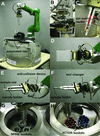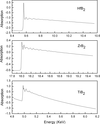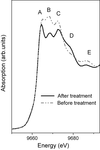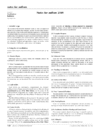issue contents
January 2009 issue

Cover illustration: Multi-modal X-ray images of bee, moth and lavender flower with three contrast mechanisms: attenuation contrast, differential phase contrast and dark-field contrast (see Bech, Bunk, David, Ruth, Rifkin, Loewen, Feidenhans'l and Pfeiffer, pages 43-47). Images are recorded at the Compact Light Source, an X-ray source based on inverse Compton scattering, the first of its kind. Phase contrast and dark-field images are obtained with a grating interferometer.
facility information
research papers
The dynamic performance of the beam position monitor support at the Shanghai Synchrotron Radiation Facility is studied by finite-element analysis and vibration measurements. The mechanical stability of the support is improved by changing the connections between the support and the ground.
Numerical design and nanofabrication procedures for the production of diamond-based kinoform refractive X-ray lenses are discussed; a test of a focusing action of a single lens is presented.
An upgraded version of the sample changer CATS (Cryogenic Automated Transfer System) has been developed on the FIP-BM30A beamline at the ESRF. This system has the ability to manage any sample standard stored in any kind of puck
An overview of the combined microRaman/microdiffraction set-up at the European Synchrotron Radiation Facility's microfocus beamline, including typical beamline application examples, is given.
Lattice vibrations have been investigated in TiB2, ZrB2 and HfB2 by temperature-dependent EXAFS experiments. Data clearly show that the EXAFS oscillations are characterized by an anomalous behavior of the Debye–Waller factor of the transition-metal–boron pair.
An X-ray magnetic circular dichroism study performed at the Ho L2,3-edges in Ho6Fe23 as a function of temperature is presented.
First X-ray phase-contrast imaging results recorded at the Compact Light Source, a laboratory-based inverse Compton X-ray source, are reported.
Download citation


Download citation


A pressure study of the α-ReO2 structure up to 1.2 GPa using synchrotron X-ray powder diffraction and X-ray absorption spectroscopy is reported for the first time. To study the α-ReO2 phase under hydrostatic pressure, a new boron carbide anvil pressure cell that can be used in absorption and diffraction X-ray experiments in any synchrotron radiation facility has been developed and built.
Using X-ray fluorescent computed tomography (XFCT), the in vivo and ex vivo cerebral distribution of a stable-iodine-labeled cerebral perfusion agent has been recorded in the brains of mice. Results highlight the sensitivity of XFCT and its considerable potential to evaluate cerebral perfusion in small animals without using radioactive agents.
In situ XANES experiments were performed to investigate the disorder to order transition in nano-sized zinc ferrite.
The Brazilian Synchrotron Light Laboratory is the only synchrotron radiation source in Latin America. Here the design, technical set-up and experimental parameters of the first wiggler macromolecular crystallography beamline (MX2) at this synchrotron source are described. Parameters of the X-ray diffraction data sets collected at the MX2 are also provided.
A pre-focused X-ray beam has been used to illuminate a single-bounce capillary in order to generate a high-flux X-ray microbeam at the BioCAT undulator X-ray beamline at the Advanced Photon Source. The combined optical arrangement makes it suitable for many microprobe fluorescence applications and micro-XANES experiments for biological samples.
A method for positioning diamond anvil cell samples at a centre of rotation is described and evaluated, after which the practice of rocking properly centred polycrystalline samples is examined. These selected techniques are crucial to optimizing the quality of data, and hence the accuracy of structural parameters, obtained from microscopic samples submitted to extreme pressure conditions.
A dedicated small-angle X-ray scattering beamline with a superconducting wiggler source at the NSRRC
A dedicated SAXS beamline with a superconducting wiggler source has been installed at the NSRRC to provide a low-divergence beam of 1010–1011 photons s−1 in the energy range 5–23 keV for nanostructural research.
A Geiger-mode avalanche photodiode array for X-ray photon correlation spectroscopy is presented.
Open  access
access
 access
accessAn experimental set-up for time-resolved X-ray absorption spectroscopy with 100 ps time resolution at beamline NW14A at the Photon Factory Advanced Ring is presented.
short communications
An imaging system based on a polycapillary half-focusing X-ray lens and synchrotron radiation source has been designed.
current events
Free 

international union of crystallography
Free 



 journal menu
journal menu











































